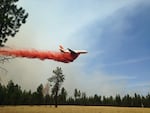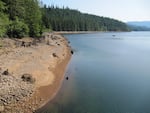Of all the resources that hang in the balance as firefighters attempt to slow the growth of the Eagle Creek Fire, one stands out: the Bull Run watershed.
It’s 150 square miles of hemlock, fir and cedar trees just south of the Columbia River Gorge. The forest soaks up rain and fills the lakes and reservoirs that provide drinking water for close to 1 million people in Portland, Gresham, Beaverton and Tigard.
The watershed is part of the Mount Hood National Forest. It’s protected by special legislation that limits logging, hiking and most human activities to avoid contaminating the water.
On a map, the boundaries of the Bull Run are shaped like a triangle, with its tip pointing at the Columbia Gorge.
As of Thursday, the perimeter of the Eagle Creek Fire looked a little like a claw reaching for the Bull Run.
“The fire is all across the north flank of the watershed, within the gorge,” said Edward Campbell, director of resource protection and planning for the Portland Water Bureau. “It’s not too nuanced. The widespread nature of the fire, the weather forecasts of not seeing significant rains mean that we’re going to be coexisting with this fire for some time.”
Campbell said the fire is without question the most serious threat to Portland’s drinking water supply in many years. Fire managers said Thursday they were allocating additional crews and resources to help protect the Bull Run.
Related: Eagle Creek Fire Near Bonneville Dam Stretches BPA Thin
They’ve identified a Bonneville Power line on the northwest edge of the watershed and some old roads that could serve as a fire line if needed and a small lake in the watershed where helicopters can fill up buckets of water to drop on the fire.
“We are allowing helicopters to draw water from Blue Lake. It is not a body of water that we supply to you as customers,” said Nicole Adams, a bureau spokeswoman.
More controversially, Campbell said the bureau has authorized the U.S. Forest Service to drop fire retardant in the watershed if necessary.
“The current circumstances are such that we do not in any way want to provide any restrictions in the set of tools that the firefighters have,” he said.
The retardant is fertilizers, made of ammonium compounds mixed with water, which can form a combustion barrier between fire and vegetation.

A heavy air tanker flies over the Milli Fire in the Three Sisters Wilderness in Central Oregon.
Central Oregon Interagency Dispatch Center
A fire management plan for the Bull Run, written in 2014, spells out the possibility that the Forest Service may need to use such chemicals during an extended firefight — but only with prior approval from the Water Bureau.
In recent years, the Forest Service has come under criticism for using retardant too often — and for the harm retardants can cause to fish populations. In 2011, the agency agreed to direct firefighting pilots not to drop the stuff within 300 feet of waterways.
Firefighters have yet to actually use retardant in the Bull Run, Campbell said. If that does happen, the Water Bureau will test for any impacts to water quality.
“The types of issues we’d be looking at are the same you would find from a discharge of fertilizer into an area,” he said.
A Pristine Water Source
The Bull Run has provided Portland with abundant, pristine and affordable drinking water for more than a century. It’s a point of pride for many Portlanders.
The water supply is also uniquely vulnerable to a large fire.

The banks of Reservoir 1 in the Bull Run Watershed.
Cassandra Profita / OPB/EarthFix
It’s one of the last unfiltered drinking water sources of any large city in the country, making it ill-equipped to respond to erosion and changes in water quality that a fire can trigger.
A 2007 management agreement between the Forest Service and the city of Portland spells out what could happen if a fire burns a significant percent of the watershed area.
“The impact on water quality of a large stand replacing fire would be immense, and would cause a very significant multi-year water supply emergency for the City of Portland and its wholesale customers,” the document states.
To be clear, Portland is still far from that nightmare scenario.
On Tuesday, the Portland Water Bureau announced the Eagle Creek Fire had crossed into the Bull Run Management Unit boundary.
But they also said repeatedly that the city’s water supply remains safe.
The point at which the fire has encroached into the Bull Run management area is about 15 miles from critical infrastructure in the watershed. That includes the two reservoirs, and Headworks, which is the intake and treatment facility at Bull Run.
And while the city has evacuated some non-essential employees from the watershed and canceled maintenance operations, four people have remained on site to keep the system running.
In other places, the fire has pressed even closer to that critical infrastructure. At Larch Mountain, the fire is burning less than 5 miles as the crow flies from Reservoir 1, and less than 8 miles from Headworks.

The Eagle Creek Fire was burning less than 5 miles from Bull Run Reservoir 1 as of Thursday, Sept. 7, 2017.
Google Maps
Area History With Fire
To put the threat posed by the Eagle Creek Fire in historical perspective, it’s been more than 100 years since a major fire burned in the Bull Run watershed.
More than half the forest in the Bull Run is classified as old growth, and the last time a catastrophic fire burned the entire watershed was in 1492.
Scientists who reviewed the watershed in a 2001 paper described much of it as “older forests unburned for centuries.”
If a fire does burn through the Bull Run, the short-term impact is likely to be manageable, Campbell said.
The Water Bureau has been monitoring ash fall into the reservoirs, and so far, it’s had no discernible effect on water quality.
If the Eagle Creek Fire forced the agency to evacuate its remaining staff, they’d have to shut down Headworks and switch over to the city’s backup water supply: groundwater wells along the Columbia River.
Those wells supply a little less water daily than the Water Bureau typically delivers to customers late in the summer.
At a recent Portland City Council meeting, Commissioner Nick Fish, who oversees the Water Bureau, described this as a “the worst-case scenario.”
“If we are required to go to well water,” he said, “our capacity is slightly below what we’re currently delivering through the Bull Run. So there will be an appeal, if we do that, by the mayor and me for people to exercise prudence around conservation.”
Fish added: “This would not be the greatest time to leave your sprinklers on all day, or take your 15th bath all day.”
In that scenario, Campbell said he expects the Headworks treatment facility, which is surrounded by a concrete parking lot, would be up and running again within a few days. And the Bull Run reservoirs would soon be back online.
The real risks to the system likely wouldn’t strike until winter. Then, heavy rains could erode the fire-scoured landscape, washing mud and debris into the reservoirs.
Other water systems manage mud and dirt — "turbidity," in water-system speak — by filtering their water. But because the Bull Run system has been historically free of sediment and other contaminants, Portland received a waiver to federal filtration requirements.
So the only option, if turbidity exceeded federal limits, would be to switch over to the groundwater system.
“If we were faced with more frequent episodes of increased turbidity, that would then require us to do more frequent shutdowns of the Bull Run,” Campbell said.
That could mean drawing water from the Columbia wells more frequently, potentially for several years in a row.
If that happened, Campbell said, “We’d be really starting to put a lot of stress on our groundwater system.”
Related: Portland City Council Moves Forward With Water Filtration Plant
In fact, the risk posed by a large fire that could burn the Bull Run forest canopy was among the factors that drove the Portland City Council earlier this summer to approve a plan to build a new $500 million filtration plant.
But that plant won’t be built for a decade, at least.
In the meantime, Campbell and the bureau face a 30,000-acre fire at the watershed’s doorstep.
Still, he — and the nearly 1-in-4 Oregonians who rely on the Bull Run for their tap water — might get lucky this time.
This weekend, the forecast is calling for cooler temperatures — and maybe even a little rain.
